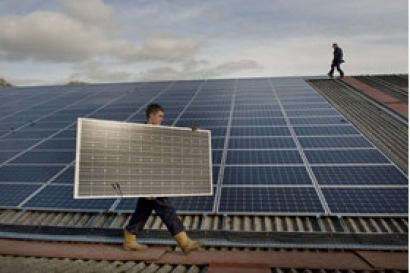
A returns ‘Calculator’ devised by the Solar Trade Association (STA) [1] for its members, based on credible data, clearly shows the good returns that domestic customers can expect from solar PV systems, even for those installed after today's FIT cuts.
Returns for investors in solar power over recent months have been exceptionally attractive [2] and the rate of solar installations is again on a steady upward trend, after a drop-off in April. The new calculations mean the STA and its members are confident that investment in solar will still be attractive after today’s FIT reduction.
The STA Calculator illustrates returns with the following example: for a family installing a large 4kW system in August costing £8,000, using 50% of their power in the home and exporting 50%, the STA Calculator shows the system will have paid for itself within 10 years, with returns of 9.2% over the 20 year life of the FIT [3]. The solar power system itself is likely to last around 40 years providing many years more of household savings!
Householders are advised (for example by REAL) to always get three quotes for solar installations as solar prices continue to come down and it may be possible to better the example cited. The REAL Assurance website provides top ten tips for consumers thinking of generating their own energy [4]
"Our figures show that solar is a no-brainer investment. Compared to the returns you can get these days in banks and many other investments, solar provides a very solid and attractive return. That is particularly the case if you consider energy bills are rising faster than anyone expected,” comments STA CEO, Paul Barwell. “Investors in solar are also helping us to drive an exciting energy revolution, putting power in the hands of everyday people, while saving the planet."
The STA Calculator is based on the Government's own projected increases in electricity prices and on established national average yields from solar power. In practice electricity prices are rising faster than Government is projecting and power yields from solar in some parts of the country are higher. Consumers who use more than 50% of the power their solar generates in the home can expect higher returns, while returns will be lower for consumers who use less.
Because solar partly replaces the import of electricity from the grid, this is an important part of the returns calculation [3]. In reality electricity prices are rising faster than the Government data used in STA's model predicts. This means households could save even more money by switching to solar. Analysis of Government statistics by the REA shows that the average annual increase in electricity bills for the period 2005 to 2011 was 6.6% above inflation. While the STA Calculator is based on conservative assumptions, using this real-world rate of increase in electricity prices means returns on the example above of a 4kW system for a family home installed in August, rise from 9.2% to 11.4%, with payback after 9 years.
“Nobody knows what electricity prices will be in future but we do know they have gone up substantially over the past few years. This trend may well continue as the UK becomes more reliant on importing its energy in an increasingly competitive world,” says Barwell. “Solar gives people the opportunity to take control of their electricity bills and help us move away from damaging fossil-fuel dependence. We believe the smart money is on solar.”
According to the STA, the solar PV industry is delighted that the vital role of solar has now been recognised by Government, with the Department of Energy and Climate Change now looking to revise its Renewables Roadmap to properly reflect the large contribution expected by solar power in 2020.
1. Households can earn and save money by investing in solar power through a number of factors. Firstly they earn an income from all the solar power they generate from the FIT, whether that is consumed in the house or exported to the grid. Secondly when they are using their own solar power they don’t have to import power from the grid and therefore they are saving on their power bills. Finally, any power exported to the grid attracts a modest export ‘bonus’ payment to reflect its market value – this will be increased in August.
2. Prior to 1 August, all numbers assume 850 kWh/kWp yield per year; 25 year tariff and generation with 50% deemed onsite usage and 50% exported; starting price grid electricity retail at 15p with 2.6% growth above inflation per year (real return used by DECC); numbers represent real rates of return (no inflation), so represent money in today’s terms (NPV). For installations before August the generation tariff = 21p; export = 3.2p; Ongoing maintenance costs for the 25 year period estimated at £2,000 which represents 1%/year on the capital cost of £8,000. Returns for a 4kWp system installed July for £8,000 are 11.8% and the system will have paid for itself in 9 years.
3. In August revised numbers on the example above reflect the fact that the FIT for domestic systems will reduce to 16p and the FIT lifetime will reduce to 20 years. However, power exported back onto the grid will increase to 4.5p, better reflecting the true market value of locally generated power. For a family installing a 4kW system in August costing £8,000 the average per annum return over 20 years of generation and export, but 25 years of usage is 9.2%. The system will have paid for itself within 10 years. The STA calculator excludes the general inflation rate in its forward price projections to leave a real rate of electricity price inflation.
For additional information:

